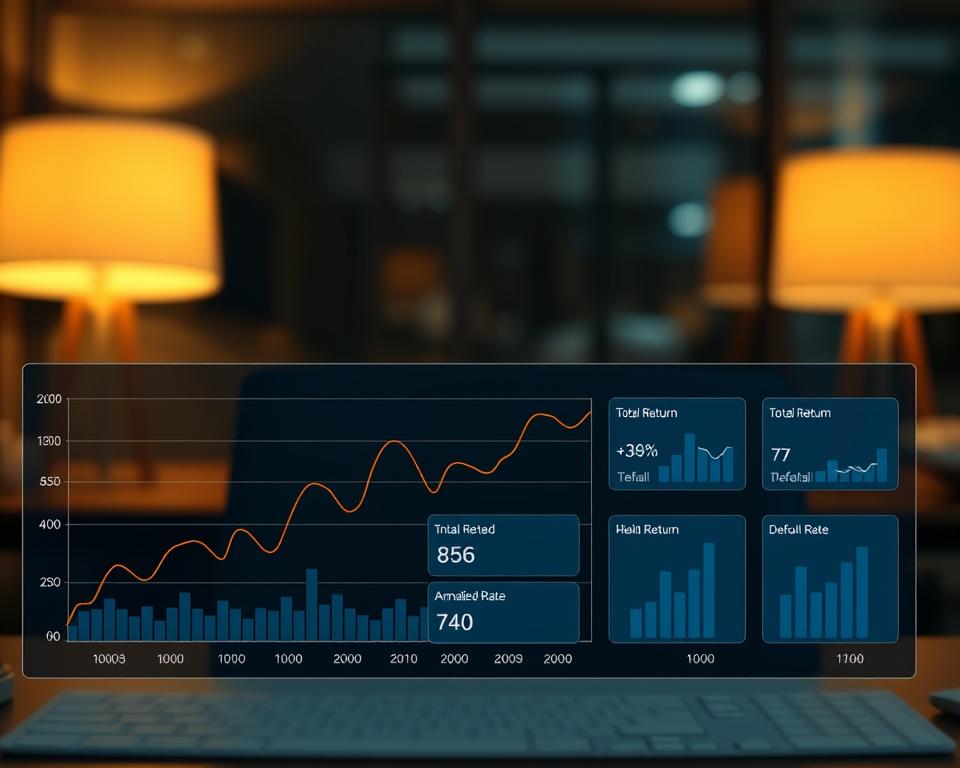Track Your CLO Capital Performance Productively
Have you discovered that CLOs across America have grown into an vast $1.1 trillion industry? This development is not merely about numbers. It reflects the financial market’s complication and CLO capital’s evolving function for investors such as big pension schemes and private wealth offices. The rise of sophisticated investors in CLOs underscores the significance of mastering CLO equity performance tracking.
Allocating funds to CLO equity investments presents multiple benefits, appealing to a broad spectrum of stakeholders. The possibility of significant gains and regular cash distributions constitutes CLO funds a beneficial supplement to multifaceted portfolios. This unique value proposition highlights their attractiveness. Participants are captivated by CLO capital for its profit capacity, often aiming for returns in the mid-teens, akin to those pursued in private equity. This charm endures, even with fluctuating interest rates and economic shifts. CLOs, with their 150 to 200 diverse positions, offer a measure of safety infrequent in targeted portfolios. I intend to supply you with the critical metrics and perspectives for index results, assisting in making prudent investment choices.
Grasping CLOs: A Comprehensive Synopsis
Collateralized debt obligations (CLOs) are complex monetary instruments. They consolidate multiple leveraged loans, selling them in slices to investors. Grasping CLOs is crucial as they supply corporate financing solutions. Over three and a half decades, their evolution has radically transformed investment strategies for institutions. The following segment offers an understanding of the CLO market’s historical evolution and current trends. It spotlights crucial trends and features influencing participants.
How would you define a CLO?
CLOs provide a new technique for handling leveraged loans. They combine more than 200 below-investment-grade, well-secured corporate loans. This tactic aims to minimize risk while generating enticing returns. The American CLO market has been thriving, now exceeding $1 trillion as of March 2024. Since 2012, it’s grown roughly 10% yearly. Despite a slowdown in growth to about 6% in 2023, a minor decline to 1% is anticipated in early 2024. Importantly, the prime segments, AAA and AA, remain default-free, underscoring CLOs’ stability.
The Expansion and Development of CLOs Over Time
The evolution of CLOs is characterized by their robustness in the face of market declines. The economic crisis proved this resilience; CLOs maintained strong credit standing with reduced defaults, unlike corporate bonds. After dipping to $263 billion post-crisis, the market rebounded remarkably. By September 2023, it reached $970 billion. This growth showcases their reliability within current CLO market conditions.
Emerging strategies, such as CLO ETFs, have driven the market additional progress. It’s now worth $15 billion, thanks to increased trading and liquidity. In the United States, a recent CLO deal averages around $500 million. Europe sees slightly smaller deals, normally €400 million. The lion’s share, sixty to sixty-five percent, is assigned to senior tranches. The equity segment constitute about 9%-10%.
Starting with comprehending CLO essentials to comprehending their evolution and contemporary trends, it’s clear they’re indispensable in investment markets. They exceptionally balance risks with returns for participants.
The Appeal of CLO Share Investments
Investing in CLO equity investments offers multiple benefits, appealing to a wide range of investors. The potential for high returns and regular cash distributions makes CLO funds a worthwhile component to diverse portfolios. This distinctive offering reinforces their appeal.
Key Benefits for Participants
CLO share stands out for its promise of double-digit yields. These investments are predicted to yield low to mid-teens returns. Regular cash distributions further enhance the allure of CLO mutual funds, particularly for income-focused investors. Moreover, robust market fundamentals, like low default rates, increase confidence in these investments.
Historically, CLO share has experienced lower default rates than traditional debt instruments. Despite potential financial stress in various areas, expected default rates should remain low. During economic downturns, high loan spreads can benefit CLO stakeholders. This allows for wise loan selection to mitigate potential losses.
CLO Equity Compared to Other Asset Types
Comparing CLO capital with other asset classes highlights its unique benefits. It offers enhanced liquidity than private equity investments without sacrificing returns. Even with recent spread narrowing, CLOs offer superior yields than similarly rated debt, demonstrating its appeal.
| Asset Class | Returns | Default Occurrences | Ease of Conversion |
|---|---|---|---|
| CLO Equity | Modest Double-Digits | Lower than debt instruments | Moderate; less liquid than Treasuries |
| Private Investments | Varies; typically lower liquidity | Variable, depending on market phase | Poor; frequently illiquid |
| High-Yield Bonds | Exceeding Treasuries | Increased defaults relative to CLOs | Robust; very liquid |
Demand for CLOs continues to be robust, suggesting an optimistic forecast for 2024. Competitive financing rates, due to a favorable spread balance, boost this asset. For investors navigating the dynamic market, an insight into CLO equity can be vital for effective strategy development.

Assessing CLO Equity Performance: Indicators and Instruments
For return-driven investors, exact assessment of CLO capital performance is crucial in the complex financial arena. The proficient application of CLO equity performance metrics substantially enhances investment strategies. Comprehending essential performance indicators (KPIs), like cash flow allocations, net asset value (NAV), and operating expense ratios is essential. They provide profound understanding of the operational effectiveness of CLO investments.
Essential KPIs for CLO Capital
CLO equity holders monitor diverse metrics to efficiently assess performance. Key metrics include:
- IRR: This metric is vital for assessing long-term profitability.
- Cash Return Ratio: Offers insights into how cash distributions compare to invested capital.
- Net Value of Assets (NAV): Indicates the market value of a firm’s assets, essential for assessing CLO worth.
- Distribution Rate: Generally about 50% of the cash flows from underlying assets.
- Default Frequencies: Have historically varied from 2% to 3%, accompanied by an average 70% recovery on defaults.
Utilizing Tracking Tools Effectively
For successful management of CLO equity investments, which comprise more than $600 billion globally, effective tracking tools are vital. Companies like Flat Rock Global offer specialized tools for CLO equity performance tracking. These mechanisms allow stakeholders to continually track their portfolios.
These mechanisms help in scrutinizing performance metric trends and benchmarking against indices like the J.P. Morgan CLO Index. They also facilitate comparisons with broader indices such as the Bloomberg Bond Aggregate Index and the ICE BofA US Corporate Index.
Arriving at well-informed choices to enhance CLO share performance is feasible for investors leveraging these metrics and tools. This understanding and effective utilization pave the way for successful CLO management strategies.
Market Trends Influencing CLO Equity Performance
Examining the CLO mutual funds market trends necessitates comprehensive scrutiny of the financial landscape and its influence on investments. Market growth figures reveal a robust market, providing critical insights to investors. As of November 2024, U.S. CLO issuances attained $191 billion, a 72% growth over the previous year. This underlines an increasing fascination with CLOs in the face of economic changes.
Present Market Environment
CLO total volume has escalated to $465 billion, outdoing the 2021 high of $438 billion. October 2024 saw $59 billion, and subsequently, November delivered $26 billion, ranking as its second-best. The market expanded 1% since the year’s start, reaching a total of $1.046 trillion. Moreover, the spike in private credit CLOs (PCLOs) with a $36 billion new issuance, broke records.
Impact of Interest Rates on CLO Equity
Increasing interest rates critically affect CLO capital, mostly due to their floating-rate nature. This makes CLO investments increasingly appealing for those seeking higher returns in a variable market. Estimates imply CLO issuances in 2025 could be between $180 billion and $215 billion, propelled by supportive elements. Watching the default rate, which improved from 3.3% in January 2024 to 3.1% at Q1’s end, is vital for CLO stakeholders. This dynamic environment offers an opportunity to optimize portfolios in the context of current CLO market trends.
Dynamic Management Tactics for CLO Shares
Overseeing CLO capital positions requires an active approach. Through strategic market navigation, CLO portfolio managers aim to boost returns and mitigate risks. These professionals grasp the market intricacies. This knowledge significantly influences the success of stakeholders’ investments.
The Way Managers Enhance Returns
CLO equity managers are pivotal in enhancing portfolio results. They keep a close eye on the credit quality and pricing of loans. With this insight, they exploit market opportunities. Such diligence enables swift reactions to market changes, enhancing CLO distribution yields. The attractive default rates and low correlation with risk assets like the average US corporate 5-year cumulative default rate highlight CLOs’ investment desirability.
CLO Management Risk Mitigation Strategies
CLO equity managers use varied techniques to shield from monetary hazards. These approaches are essential for safeguarding stakeholders during volatile market periods. They concentrate on the difference between asset spreads and debt costs to optimize cash flows. The range of IRRs in CLO equity, with top quartiles reaching up to 25% and bottom quartiles sometimes falling below 0%, show the importance of these risk reduction approaches’ importance in maintaining investment stability through market changes.
The Role of CLO Index and Benchmarking
Understanding the role of the CLO index is essential for informed investment decisions. It serves as an indicator for CLO performance, mirroring market trends and influencing investor tactics. By scrutinizing these benchmarks, we obtain detailed insights into CLO metrics. This facilitates effective comparison of risk and trend patterns among diverse asset classes.
Interpreting CLO Index Results
The size of the CLO market has expanded to an impressive $1.2 trillion. It now fulfills roughly 70% of the demand for U.S. corporate financing. Such expansion underscores the need for reliable benchmarks. Here, CLO indices provide a pivotal function. They measure a wide range of performance indicators, allowing investors to assess how their investments fare against the market’s broader scope.
Comparing with Other Market Indices
Benchmarking CLO outcomes against other indices sheds light on its positioning. Typically, CLO equity involves a ratio of about 90% debt to 10% equity. Concerning safety, AAA tranches record an almost non-existent default rate. This is in direct opposition to the long-term average default rates of US corporations. Thus, CLOs are notable for their attractive yields and outstanding stability in fixed income.
Moreover, CLO performance metrics often point to a spread benefit over traditional bonds, particularly in the high-yield sectors. This results in increased prospective gains for investors along with valuable diversification perks. CLOs maintain a reduced correlation with other high-yield bonds and equities, enabling smarter CLO market positioning and more insightful investment strategy development.
Challenges in Monitoring CLO Equity Performance
Overseeing CLO capital performance is notably challenging, notably in volatile markets. Investors encounter complexities due to market fluctuations that affect risk evaluations and the identification of opportunities. These market oscillations can significantly alter default risks and acquisition decisions. Thus, deploying effective strategies is essential for sustaining prime CLO performance.
Effects of Market Instability
The outlook for the bond market suggests that fixed income participants are shifting to adaptive management approaches. This transformation intends to more effectively adjust to market instability, enhancing yields for fixed income portfolios. Currently, the credit cycle is evolving, not at its zenith, indicating sustained credit portfolio prospects up to 2025. With interest rates high, the challenges in monitoring CLOs become evident, elevating capital costs for CLO equity and underscoring the need for judicious management.
Understanding Default Risks in CLO Investments
One must comprehend the default hazards in CLO investments for proper monitoring. Evidence suggests that during recessions, CLO loan default rates could hit 3%, negatively impacting performance. The interaction of higher interest rates with lower returns further complicates various investment strategies. Notably, about 40% of CLO managers are employing advanced analytics and AI to enhance their monitoring, resolving transparency concerns and advancing performance metrics. The complexity of the assets underneath and ongoing regulatory changes introduce additional challenges in managing CLO equity performance effectively.
Prospective Future for CLO Capital Investments
The arena of collateralized loan obligations (CLOs) is undergoing a change. This evolution heralds a future for CLO equity investments marked by promise and complexity. Insights into market trends highlight considerable opportunities borne from shifts in supply, demand, and interest rates. A significant leap in new issuances in 2024, totaling $199.8 billion signals a robust recovery. This number represents a 72% increase over 2023 and exceeds past records, affirming the importance of CLO equity in investments.
Unprecedented refinancing and restructuring actions, amounting to $309.1 billion in 2024, validate investor confidence in CLOs. This reveals promising prospects, notably for participants poised to manage shifting market trends.
Potential Opportunities in the Current Landscape
As regulatory changes such as Basel III loom, an estimated $190 billion could enrich the market. These changes aim to bolster the appeal of AAA, AA, and single-A CLO tranches, forecasted to result in increased demand. CLOs continue to offer attractive total returns, notably in lower-rated tranches. This showcases their impressive performance and the risk-adjusted rewards they carry.
Predicted Trends and Changes to Watch For
Several forecasted shifts in CLO investment merit consideration. The potential for narrower spreads and improved liquidity looms, influencing investment approaches. The historical resilience against defaults makes CLO equity a comparatively secure option in volatile markets. With strong new issuance expected in 2025, astute investors prepared to adjust their strategies may achieve substantial gains amid changing conditions. It’s crucial for investors to keep an eye out for opportunities in secondary equity positions for appealing cash-on-cash returns.
As a Final Point
In summary, effectively tracking CLO equity performance is crucial for participants engaging in this specialized asset category. Considering the CLO market’s current valuation exceeds $1.1 trillion, of which CLO equity represents roughly $100 billion, it’s clear. These investments offer strategic advantages not to be overlooked.
Active management’s importance in boosting CLO performance during critical reinvestment phases cannot be overstated. Considering the volatility in the CLO market, such as fluctuations in interest rates, market dynamics, and transaction timings, it’s essential for investors to remain knowledgeable and proactive. This approach ensures they can adapt strategies as necessary, maximizing CLO investment potentials.
For those informed investors, diving into CLO equity opens up remarkable career possibilities. The mix of diversification benefits and the chance for significant returns illustrates the importance of CLO equity in a well-rounded portfolio. Looking ahead, keeping pace with market trends and engaging actively in the CLO sphere promises substantial rewards. This underscores the value of a meticulous CLO investment strategy.
FAQ
What is a CLO?
Collateralized loan obligations (CLOs) merge multiple leveraged loans, which are then divided and marketed to investors, thereby providing a unique avenue for engaging in corporate finance.
What are the main benefits of investing in CLO equity?
CLO equity investments deliver substantial benefits such as elevated returns, steady cash flows, low correlation with other asset types, and the possibility of enhanced performance through expert management.
How do I track CLO equity performance?
Monitoring CLO equity involves concentrating on essential performance indicators such as cash flow distributions, net asset value, and expense ratios, with the aid of tracking tools provided by firms like Flat Rock Global.
How do market trends influence CLO equity performance?
Market trends, notably interest rate shifts and economic dynamics, greatly impact CLO equity outcomes. CLO investments can yield higher income as interest rates rise, given their floating-rate nature.
How do CLO managers enhance equity returns?
CLO managers boost returns through effective trading and risk management. They hone in on the credit quality and pricing of loans. Adapting to market changes is also crucial.
How do CLO indices contribute to performance evaluation?
CLO indices are vital for evaluating performance. They help investors compare the success of CLO equity to broader market measures. This aids in understanding the risk-return dynamics.
What obstacles can arise in tracking CLO equity performance?
Navigating market volatility poses challenges for investors. It influences the assessment of default risks and the timing for purchasing opportunities. Thus, investors must continuously scrutinize the underlying loans.
How is the future for CLO equity investments expected to unfold?
The future for CLO equity investments looks bright. The evolving market landscape and potential shifts in interest rates promise opportunities for investors to refine their strategies.


